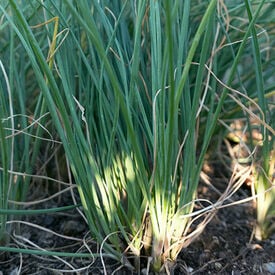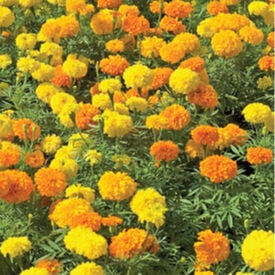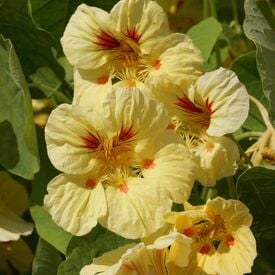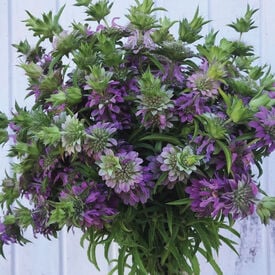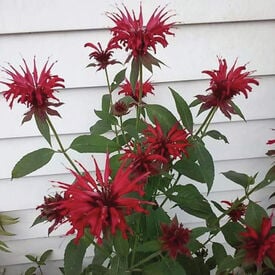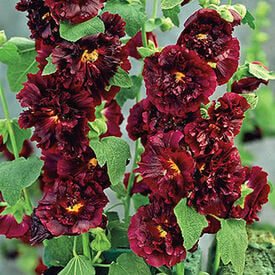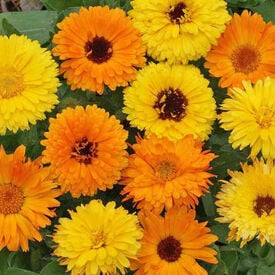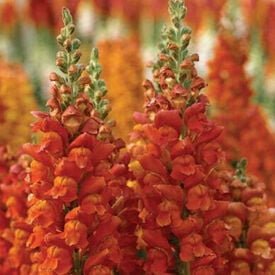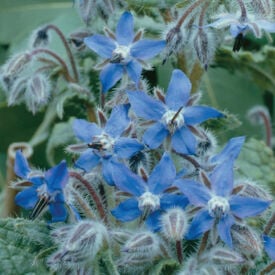The standard Chive is a hardy perennial herb that is equally attractive as it is delicious. The 6-12 inch tall clumps are perfect for patio containers! Along with the delicate, flat onion-flavored leaves, the standard chives is also popular for the cut and come again lavender flowers. This organic favorite is widely used as flavoring in many dishes.
The Crackerjack Marigold is a festive flowing plant that produces huge, bushy blooms of carnation-like flowers on tall stems. This variety blooms yellow, gold and orange that adds a beautiful pop of color to any garden!
Peach Melba nasturtium is a captivating variety of Tropaeolum majus renowned for its unique and elegant appearance. Originating from the vibrant tradition of nasturtium cultivation, this particular cultivar stands out for its delicate, peach-colored blossoms that blend seamlessly with its lush green foliage. Named after the famous Peach Melba dessert, this variety features soft, peach-hued flowers with a subtle mix of apricot and coral tones, which bloom prolifically throughout the growing season. Peach Melba nasturtium typically begins blooming in late spring and continues to flower until the first frost. The plants exhibit a trailing or climbing growth habit, making them ideal for cascading over containers, hanging baskets, or as ground cover. Known for their versatility and resilience, these nasturtiums thrive in well-drained soil and full sun to partial shade, adding a splash of color and a touch of elegance to gardens. Additionally, the flowers and leaves of Peach Melba nasturtium are edible, offering a peppery flavor that can enhance salads and garnishes. With its stunning color, extended bloom time, and attractive growth habit, Peach Melba nasturtium is a beloved choice for both ornamental and culinary uses.
The Alaska Nasturtium is a beautiful golden yellow to orange variety that looks great in patio containers and hanging baskets! you are able to plant 3 to a 10" inch basket! The Alaska produces 100% variegated foliage.
Attracts butterflies and hummingbirds to the garden. Packed with tiny blooms on burgundy stems, this fragrant perennial is great for cutting. Quick growing with a great mint aroma.
Lemon Mint Bee Balm grow beautiful lavender blooms that make wonderful cut flowers. Citrus scented blooms offer fragrance and beauty. The blooms and leaves are both edible. Native to the U.S. Also known as lemon bee balm, purple horsemint, and lemon mint. If grown in a pollinator garden Lemon Mint will attract bees, butterflies, and hummingbirds.
The Panorama Red is a great cutting plant for center pieces. Produce vibrant red blooms from July to August on 3' foot plants.
The Nasturtium Single Mix is a vibrant mix of lovely shades of red, orange and yellow flowers that are sure to grab your attention! This mix is a beautiful annual that blooms its 2-3 inch blossoms from June until first frost. Its leaves, flowers and seeds are all edible, with the leaves having a peppery flavor which makes a great addition to your salads. The seeds were actually used as a pepper substitute during WWII, or you can pickle the seeds when they are still green.
Produces large, fully double maroon flowers on tall, well-branched plants in a range of attractive colors. Blooms summer to late summer for extended color in garden beds. Very popular as a background in borders and against fences. Can be used as a backyard cut flower.
The Pacific Beauty Mix Calendula is a beautiful golden yellow and orange pot marigold that makes for excellent cut flowers. This Calendula variety is a customer favorites for brightening up a room in a vase or lending beauty to many dishes as edible flowers. This annual prefers cooler climates that look great in different containers and pots. The Pacific Beauty Mix's peak blooms occur in spring through summer.
A cooler growing Snapdragon for the early spring days or into the autumn if given shelter. Beautiful seville orange in color makes this variety very attractive for flower arranging. Great for cut-flowers and bouquets. Ht. 24-30". Avg. 194,000 seeds/oz. Packet: 25 seeds.
Borage is a mounded plant that produces beautiful blue flowers that are great for using as a garnish for different dishes or drinks. This large variety is a self seeding annual that bears hundreds of small edible flowers, mostly blue and some pink, over a long harvest. Borage has a mild cucumber flavor that is great for salads and garnishes. Medicinal: Seed oil is a rich source of gamma-linolenic acid.
